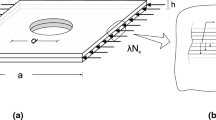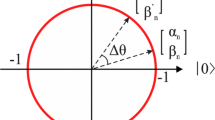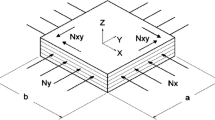Abstract
To improve the buckling resistance, a variable stiffness (VS) layup optimization strategy is proposed by considering the constraints of manufacturing process. By considering the curvature constraints of fiber-tow paths during the fabrication of VS laminates, the constrained Kriging model is bult to relate the design variable of layup configuration with the buckling resistance. The first eigenvalue obtained from the eigenvalue buckling analyzing is set as the objective function, and used to establish the constrained Kriging model. With the help of the multi-island genetic algorithm (MIGA), the global optimal solution is searched, and the influence of VS layups on buckling of composite laminates is analyzed. Taking a uniaxial compressive buckling case for example, an optimized layup configuration has been obtained. By investigating the effectiveness of the optimization strategies, buckling characteristics of four laminates with different layup configurations have been simulated by nonlinear buckling analyzing, and have been proved by the compressive buckling tests. By comparing the buckling responses of the analytical model and the experimental results, it can be found the laminate with optimized layup configuration has a much better buckling resistance ability. Compared with traditional constant stiffness (CS) laminate, the buckling stiffness and ultimate load have been improved by 41.1% and 113.58%, respectively.








Similar content being viewed by others
REFERENCES
P. Wang, X. Huang, Z. Wang, et al., “Buckling and post-buckling behaviors of a variable stiffness composite laminated wing box structure,” Appl. Compos. Mater. 25 (2), 449–467 (2018). https://doi.org/10.1007/s10443-017-9643-3
J. Zhong, C. Zhao, J. Ren, et al., “A constitutive model for carbon fibre reinforced epoxy resin laminate under compression load: considering the initial non-linearity,” Appl. Compos. Mater. 29 (2), 629–649 (2022). https://doi.org/10.1007/s10443-021-09979-8
X. Zhang, W. Dai, B. Cai, et al., “Numerical and experimental investigation of bearing capacity for compressed stiffened composite panel with different stringer section geometries,” Appl. Compos. Mater. 29, 1507–1535 (2022). https://doi.org/10.1007/s10443-022-10030-7
D. Liu, R. Bai, R. Wang, et al., “Experimental study on compressive buckling behavior of J-stiffened composite panels,” Opt. Lasers Eng. 120, 31–39 https://doi.org/10.1016/j.optlaseng.2019.02.014
Y. B. SudhirSastry, P. R. Budarapu, N. Madhavi, et al, “Buckling analysis of thin wall stiffened composite panels,” Comput. Mater. Sci. 96, 459–471 https://doi.org/10.1016/j.commatsci.2014.06.007
P. Ribeiro, H. Akhavan, A. Teter, et al., “A review on the mechanical behaviour of curvilinear fibre composite laminated panels,” J. Compos. Mater. 48 (22), 2761–2777 (2013). https://doi.org/10.1177/0021998313502066
X. Niu, T. Yang, Y. Du, et al., “Tensile properties of variable stiffness composite laminates with circular holes based on potential flow functions,” Arch. Appl. Mech. 86 (9), 1551–1563 (2016). https://doi.org/10.1007/s00419-016-1126-8
J. Fazilati and V. Khalafi, “Effects of embedded perforation geometry on the free vibration of tow-steered variable stiffness composite laminated panels,” Thin Wall Struct. 144, 106287 (2019). https://doi.org/10.1016/j.tws.2019.106287
Z. Cao, M. Dong, Q. Shi, et al., “Research on buckling characteristics and placement processability of variable stiffness open-hole laminates,” Composites Part C: Open Access 7, 100233 (2022). https://doi.org/10.1016/j.jcomc.2022.100233
A. Alhajahmad and C. Mittelstedt, “Design tailoring of curvilinearly grid-stiffened variable-stiffness composite cylindrically curved panels for maximum buckling capacity,” Thin Wall Struct. 157, 107132 (2020). https://doi.org/10.1016/j.tws.2020.107132
G. Raju, Z. Wu, B. C. Kim, and P. M. Weaver, “Prebuckling and buckling analysis of variable angle tow plates with general boundary conditions,” Compos. Struct. 94 (9), 2961–2970 (2012). https://doi.org/10.1016/j.compstruct.2012.04.002
A. Milazzo and V. Oliveri, “Investigation of buckling characteristics of cracked variable stiffness composite plates by an eXtended Ritz approach,” Thin Wall Struct. 163, (2021). https://doi.org/10.1016/j.tws.2021.107750
S. W. Yang, Y. X. Hao, W. Zhang, et al, “Buckling and free vibration of eccentric rotating CFRP cylindrical shell base on FSDT,” Appl. Math. Modell. 95, 593–611 (2021). https://doi.org/10.1016/j.tws.2020.107382
S. Moradi, A. R. Vosoughi, and N. Anjabin, “Maximum buckling load of stiffened laminated composite panel by an improved hybrid PSO-GA optimization technique,” Thin Wall Struct. 160, (2021). https://doi.org/10.1016/j.tws.2020.107382
Z. Cao, G. Lin, Q. Shi, and Q. Cao, “Optimization analysis of NURBS curved variable stiffness laminates with a hole,” Mater. Today Commun. 31, 103364 (2022). https://doi.org/10.1016/j.mtcomm.2022.103364
M. A. Luersen, C. A. Steeves, and P.B. Nair, “Curved fibre paths optimization of a composite cylindrical shell via Kriging-based approach,” J. Compos. Mater. 49 (29), 3583–3597 (2015). https://doi.org/10.1177/0021998314568168
B. Keshtegar, T. Nguyen-Thoi, T. T. Truong, and S. P. Zhu, “Optimization of buckling load for laminated composite plates using adaptive Kriging-improved PSO: A novel hybrid intelligent method,” Def. Technol. 17(1), 85–99 (2021). https://doi.org/10.1016/j.dt.2020.02.020
Z. Gurdal and R. Olmedo, “In-plane response of laminates with spatially varying fibre orientations-variable stiffness concept,” AIAA J. 31 (4), 751–758 (1993). https://doi.org/10.2514/3.11613
R. M. J. Groh and P. M. Weaver, “Buckling analysis of variable angle tow, variable thickness panels with transverse shear effects,” Compos. Struct. 107, 482–493 (2014). https://doi.org/10.1016/j.compstruct.2013.08.025
Y. Tie, Y. Hou, C. Li, et al., “An insight into the low-velocity impact behavior of patch-repaired CFRP laminates using numerical and experimental approaches,” Compos. Struct. 190, 179–188 (2018). https://doi.org/10.1016/j.compstruct.2018.01.075
F. E. C. Marques, A. F. S. da Mota, and M. A. R.Loja, “Variable stiffness composites: optimal design studies,” J. Compos. Sci. 4 (2), 80 (2020). https://doi.org/10.3390/jcs4020080
F. Fuerle and J. Sienz, “Decomposed surrogate based optimization of carbon-fibre bicycle frames using Optimum Latin Hypercubes for constrained design spaces,” Comput. Struct. 119, 48–59 (2013). https://doi.org/10.1016/j.compstruc.2012.11.014
W. W. Zhang, H. Qi, Z. Q. Yu, et al., “Optimization configuration of selective solar absorber using multi-island genetic algorithm,” Sol. Energy 224, 947–955 (2021). https://doi.org/10.1016/j.solener.2021.06.059
S. Chen, T. Shi, D. Wang, et al., “Multi-objective optimization of the vehicle ride comfort based on Kriging approximate model and NSGA-II,” J. Mech. Sci. Technol. 29 (3), 1007–1018 (2015). https://doi.org/10.1007/s12206-015-0215-x
Funding
This study was supported by National Natural Science Foundation of PR China grant no. 52175110.
Author information
Authors and Affiliations
Corresponding authors
About this article
Cite this article
Niu, X., Zhang, X. Curvature-Constrained Layup Optimization to Improve Buckling Resistance of Composite Laminates. Mech. Solids 57, 1500–1511 (2022). https://doi.org/10.3103/S0025654422060103
Received:
Revised:
Accepted:
Published:
Issue Date:
DOI: https://doi.org/10.3103/S0025654422060103




